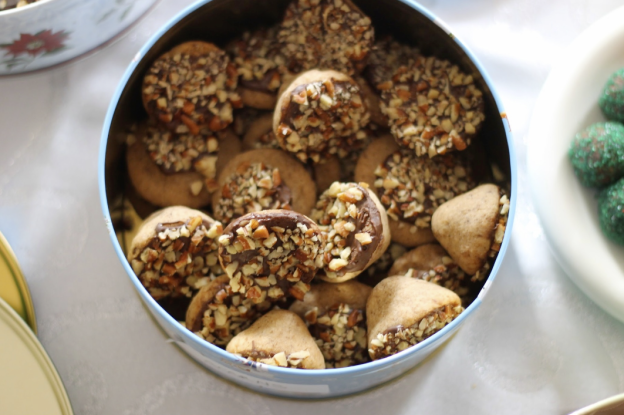Published: December 2025
Author: Grandma Rose (Rose’s Deli) & Mimi
Recipe origin: US
From Heritage Cookbook creator Janice M’s book: “Mimi’s sister, Aunt Shirley, made these cookies for many Christmases. Some of her nieces and nephews remember spending Christmas Eve day with her (she would kindly offer to take us off our parents’ hands for a good part of that day which can be the longest of the year for many children). We helped her put bows on gifts and do other last-minute tasks, one of which was dipping the acorns in chocolate and nuts!
We suggest baking a test cookie to make sure the butter/flour ratio is right and the cookies do not flatten out. If your butter is too soft when you begin, this can be a result. If your test cookie flattens, add 1/4 cup additional flour.”
1 cup butter
3/4 cup brown sugar
2 3/4 cups flour
1 tablespoon cocoa powder
1 tablespoon instant coffee powder
1 teaspoon vanilla
1/4 teaspoon salt
6 oz. chocolate chips for dipping
1 cup chopped pecans
Cream butter and brown sugar. Add sifted flour, cocoa, coffee, vanilla and salt. Mix well.
Roll dough into 4 long rolls, 1 inch in diameter. Cut into 3/4-inch sections. Roll each into a ball. Press each ball onto greased cookie sheet to flatten base and pinch top to make a point.
Bake at 325 degrees for 10-12 minutes.
Melt chocolate chips. While cookies are still warm, dip wide end into chocolate, then into chopped pecans.
Yield: 2 1/2 dozen.
Ready to turn your recipes into something memorable? Click here to get started!
November 18, 2025 | Posted in:
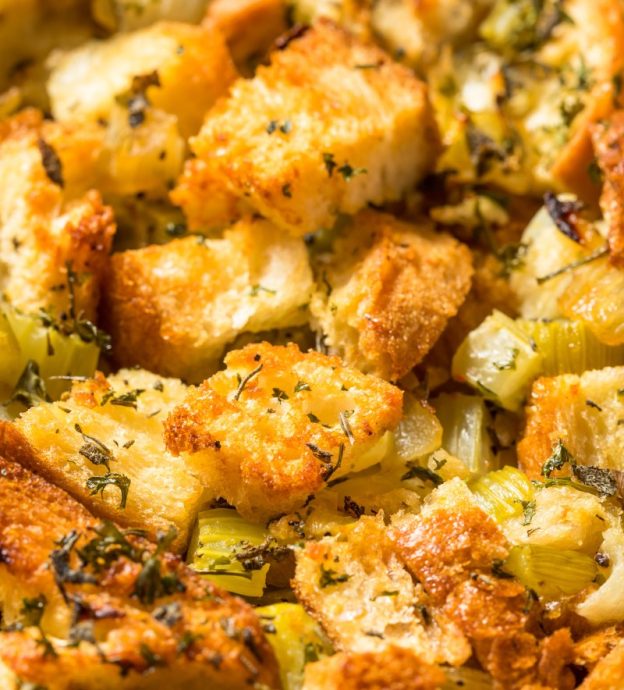
Stuffing Just like Nanny Mac made
Published on: November 20th/2025
Author: Leanne J.
Recipe origin: Canada
In Leanne’s words:
Nanny Mac had many stories of food as well. She had to feed her family and her boarders on a widows pension. When she tried to supplement her income by selling her delicious baking, her subsidy was cut off. When I was growing up, we often ate meals at her apartment. I remember how cozy it was. Simple, yet delicious food. Always a dessert after.
3/4 cup of butter
2 1/2 cups chopped onions
1 cup each chopped celery and fennel (or 2 cups celery) including celery leaves
4 tsp dried sage (don’t be shy)
1 tsp each salt, marjoram, savory and pepper
1/2 tsp dried thyme
14 cups cubed white bread
1 cup chopped fresh parsley
In large skillet melt butter over medium heat, cook onions, celery, celery leaves, fennel, sage, salt, savory, marjoram, pepper and thyme, stirring often for 10-15 minutes or until vegetables are tender. Toss with cubed bread and parsley.
Can put in turkey and cook in the bird. We usually put in casserole dish and cook in 350° oven until hot, basting with turkey fat as the turkey cooks.
Ready to turn your recipes into something memorable? Click here to get started!
October 29, 2025 | Posted in:
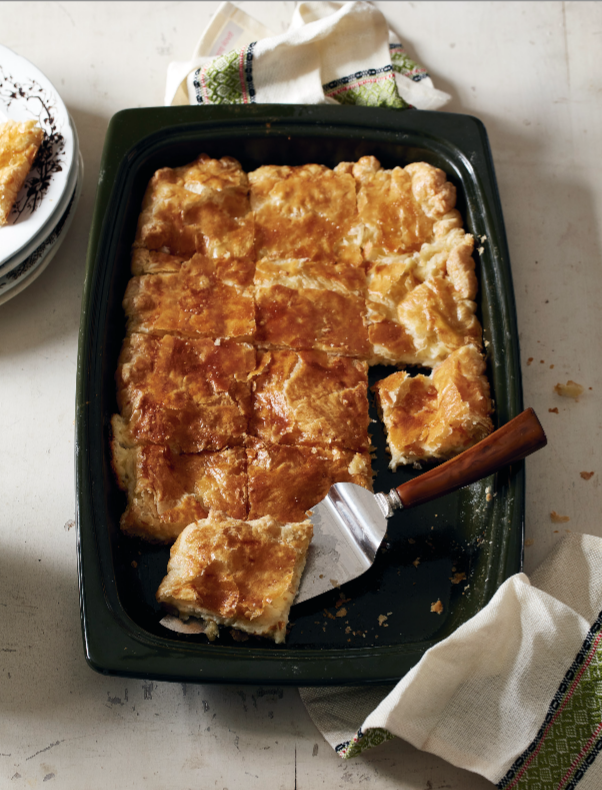
[Thanks! You’re now entered to win “Chesnok” by Polina Chesnakova!] A Recipe for Penovani Khachapuri:
Published on: November 7th/2025
Author: Polina Chesnakova
Recipe origin: Georgia
GEORGIAN FLAKY CHEESE BREAD
“This sheet-pan version of penovani khachapuri — usually sold as a compact, hand-held street food — is made with shatteringly crisp puff pastry and is nonnegoatiable at our big family parties. As the platter hits the table, a bit of a flurry ensues over who gets the corners (or, as we call them, popuchki—”little butts”). Thankfully there’s always enough pieces to go around, corner or no corner, and eventually everyone gets their fill. It’s impossible to get tired of this khachapuri, so don’t be surprised if it becomes a staple in your family, too.”
Unsalted butter, for greasing
All-purpose flour, for dusting
One (17.3-ounce / 490 g) box frozen puff pastry, thawed but chilled
1 pound (450 g) low-moisture whole-milk mozzarella cheese, shredded
5 ounces (140 g) feta cheese, grated
5 ounces (140 g) whole-milk ricotta cheese
1 egg, lightly beaten with a pinch of kosher salt
SERVES 8 TO 10
Preheat the oven to 375°F (190°C).
Lightly grease a 10×15-inch (25×38 cm) jelly-roll pan or an 11×17-inch (28×43 cm) glass baking dish, or something similar in size. These sizes will give you the best pastry-to-cheese ratio.
On a lightly floured surface, roll out one puff pastry sheet slightly larger than the size of your pan and transfer it to the pan. Sprinkle the mozzarella in an even layer over the dough, leaving a thin border all around. Evenly crumble the feta cheese over the top. Dollop the ricotta in small spoonfuls all over in an even layer.
Roll out the second piece of dough to the size of your pan and lay it over the cheese. Pinch the edges of the pastry layers together to tightly seal like you really mean it—I go over my pinches a couple of times to make sure there aren’t any gaps. We don’t want any precious cheese oozing out! Then roll the edges up and over the pie and pinch and flatten all over again. Generously brush the pastry with the beaten egg, making sure you get the edges, too. Poke the top of the pastry, save for the edges, all over with a fork—you can’t have too many pokes.
Bake the pie until crisp and golden brown and the bottom is firm, 30 to 35 minutes.
Let cool a bit for the cheese to set before cutting into squares and serving.
Ready to turn your recipes into something memorable? Click here to get started!
October 6, 2025 | Posted in:
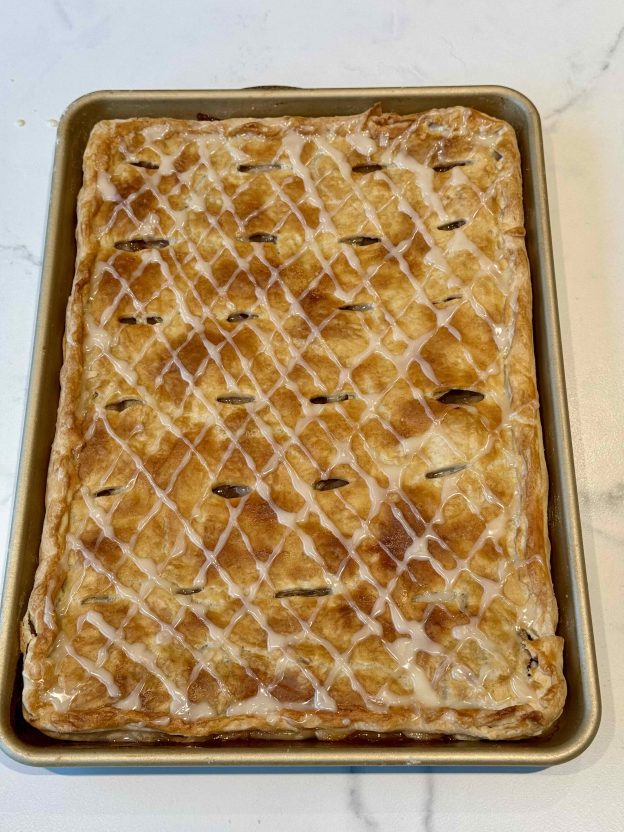
Danish Apple Bars
Published on: October 6th/2025
Author: Lindsay Anderson / Marco P.
Recipe origin: Denmark / Canada
These apple bars are perfect for a crowd!
CRUST:
2 1/2 cups flour
1 tsp salt
1 cup shortening
1 egg, separated
2/3 cup milk
FILLING:
5–6 apples, peeled and sliced
1 cup sugar
1 tsp cinnamon
ICING:
1 cup icing sugar
1 tsp vanilla
4 tsp water
Preheat oven to 400°F.
Crust:
Combine flour and salt. Cut in shortening until the mixture resembles small peas. Beat egg yolk with milk and add; mix. Form into a ball and refrigerate until cold. Divide dough in half. Roll one half between two pieces of waxed paper to fit a cookie sheet. (Per note, you can roll on a floured surface instead.)
Filling:
Spread apples on prepared dough. Mix sugar and cinnamon (I add 2 Tbsp instant flour). Sprinkle sugar mixture over apples. Roll remaining dough between waxed paper to a size to cover base; place over apples. Seal edges. Beat egg white with a fork and brush over the top crust. Make slits in the top. Bake for 30 minutes or until nicely browned. Remove from oven.
Icing:
Mix ingredients together and drizzle over apple bars while still warm.
Ready to turn your recipes into something memorable? Click here to get started!
September 12, 2025 | Posted in:
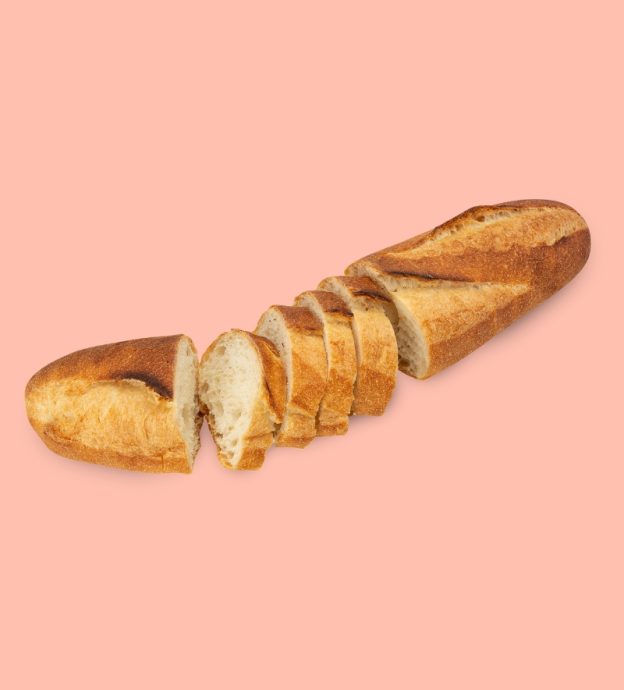
Governor’s French Bread
Published on: September 11th/2025
Author: Suzana Oliveira & June Reeder McCarthy
Recipe origin: France
This is a Frannie Packard recipe, Executive Chef at the Governor’s Residence before me. Billy Graham told Frannie that it was the best bread he had ever eaten. My family now considers it the ‘Canada French Bread’.
2 cups warm water, 100-115 degrees
1 package active dry yeast
1 tablespoon sugar
1 tablespoon coarse salt
3 1/2 – 4 cups bread flour
1. Place the water, yeast, and sugar in the bowl of an electric mixer fitted with the beater bar. Allow the yeast to proof (dissolve) about 5 minutes. With the mixer on low speed, gradually add salt and 3 cups flour. When the flour is incorporated, turn the mixer up to medium-high and beat for about 2 minutes. Reduce speed to low and slowly add about 1 1/2 cups flour, 1/2 cup at a time, until the dough wraps around the beater and cleans the sides of the bowl. You may not use all the flour. The worst thing you can do to bread dough is to add too much flour.
2. Scrape the dough off the beater bar and leave the rough mass of dough in the mixing bowl. Cover with plastic wrap and a towel. Allow the dough to rise in a warm, draft-free place until doubled in size, about 1 1/2 hours. Turn dough over itself in the bowl about 4 times. Cover, and allow to rise another 45 minutes.
3. Preheat the oven to 425 degrees. Place the dough on a lightly floured board, cut dough in thirds or half depending on your loaf pan. Roll into French loaf form. Place the dough onto a greased French loaf pan. Allow to rise with a covered towel. When the dough has doubled, make 3 slashes in each loaf with a sharp knife. Bake for 25 minutes or until a thermometer reads an internal temperature of 200 degrees. Remove from the pan immediately to cool.
Whole Wheat Variation
2 1/2 cups water for the 2 cups water
2 cups all-purpose flour & 4 cups whole wheat flour for the 3 1/2 cups bread flour
Method remains the same.
Ready to turn your recipes into something memorable? Click here to get started!
August 25, 2025 | Posted in:

Nonna Carmela’s Tiramisu – From ‘Mediterranea’
Published on: August 28th/2025
Author: Recipe by Nonna Carmela; from Mediterranea by Anastasia Miari (Quadrille, £28), photography © Marco ArgÜello
Recipe origin: Italy
Note from Anastasia: The dessert to beat all desserts, tiramisu needs little introduction. It has always been my favourite sweet ending to a meal, but when I moved to Sicily a few years ago to learn Italian and realised that tiramisù quite literally means ‘pick me up’, I fell in love with this dolce all over again.
Carmela’s tiramisù is light and creamy. It’s less saccharine than others I’ve tasted across Italy and strikes just the right balance between creamy, sweet and kicky (from the coffee). It’s also damn easy to whip up. Don’t think about adding alcohol to this one. It isn’t traditional tiramisù etiquette and Nonna Carmela would be very upset. She also advises you make it the day before to ensure a tidier slice. She served hers right after her Pasta alla Norma.
5 cups water
4 large eggs, separated
150 g (51/2 oz/scant 2/3 cup) caster (superfine) sugar
500 g (1 lb 2 oz) mascarpone, at room temperature
800 ml (27 fl oz/ 31/3 cups) brewed espresso (Carmela used 4 coffee pods), cooled
400 g (14 oz) sponge fingers (savoiardi/ ladyfingers; ideally thin ones)
2 tablespoons cocoa (unsweetened) powder
Using a hand mixer, whisk the egg whites in a large, clean bowl until soft peaks form. Be careful not to overmix them.
Put the egg yolks into a large bowl, add the sugar and whisk until pale and thickened.
Gradually add the mascarpone to the yolk and sugar mixture, whisking until combined. Add the egg whites and whisk again briefly until combined.
Now make the first layer of sponge fingers. Pour the coffee into a large Tupperware box or small baking dish. Place the dish you will use for your tiramisu next to the dish of coffee – Carmela used a 39 x 17 cm (15 x 7 inch) glass dish, but use any medium-sized deep dish you have. One at a time, dip half the sponge fingers into the dish of cooled coffee very quickly. Make sure this action is in and out in a flash – just as long as it takes to submerge the finger. They should not be soggy at all. Once you’ve submerged one finger, place it into the tiramisu dish immediately and then repeat the process until half the sponge fingers have been dipped and arranged.
Next, spread half the mascarpone mixture onto the sponger fingers. Now repeat the process with the sponge fingers to create another layer of soaked sponge fingers on top of the mascarpone layer. Finally, add the remaining mascarpone mixture and smooth out the top.
Place the dish in the refrigerator and chill overnight.
Before serving add a thick dusting of sifted cocoa.
Ready to turn your recipes into something memorable? Click here to get started!
August 12, 2025 | Posted in:
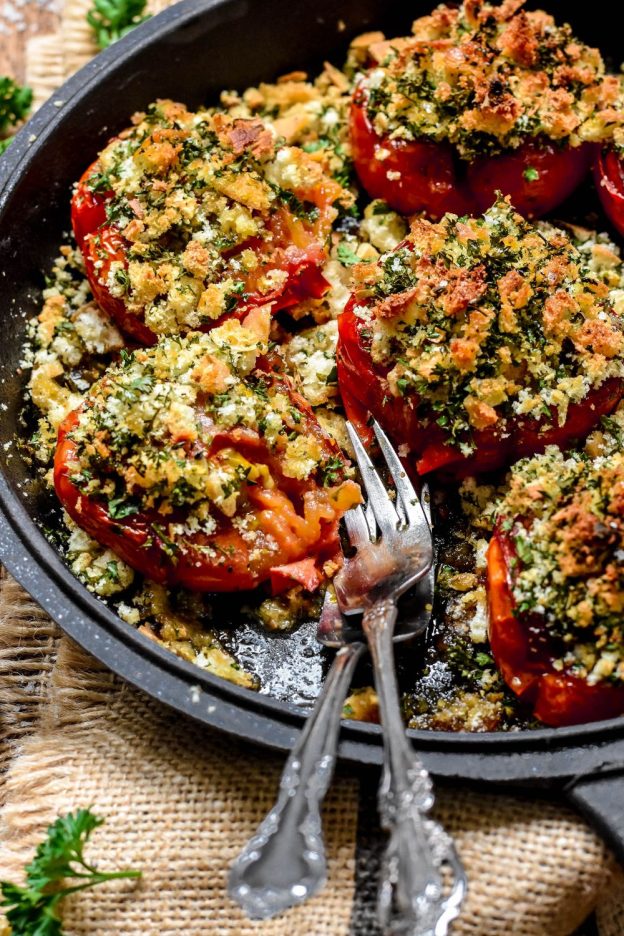
Tomates à la Provençale
Published on: August 7th/2025
Author: Suzana Oliveira & Abeille S.
Recipe origin: France
Tomates à la Provençale is a rustic French dish, especially popular in the summer when tomatoes are at their peak. Simple yet full of flavor, it celebrates the freshness of seasonal produce. This recipe combines the natural sweetness of tomatoes with the aromatic blend of garlic, parsley, and olive oil, creating a taste that captures the essence of the Mediterranean.
This recipe was contributed by Abeille, whose family moved from France to the United States when she was a child. She recently collected a number of her mother and grandmother’s favorite seasonal recipes, and her family especially loves this one served with lamb.
4 market-fresh tomatoes
A large bunch of parsley
1 garlic clove
Olive oil
Salt
Pepper
2 tablespoons of breadcrumbs
Cut each tomato in half horizontally (around the equator).
Heat a generous tablespoon of olive oil in a skillet.
When the oil is hot, place the tomatoes cut-side down in the pan.
Sear them on high heat until lightly browned (about 2 minutes), then flip them over.
Lower the heat to low/medium and cover with a lid.
Finely chop the parsley and the peeled garlic clove.
In a bowl, combine the parsley and garlic.
Add one or two tablespoons of breadcrumbs and 2 tablespoons of olive oil. Season with salt and pepper.
Spoon a generous amount of this mixture onto each tomato half.
Continue cooking on low heat until done.
Delicious served with lamb chops.
Ready to turn your recipes into something memorable? Click here to get started!
July 16, 2025 | Posted in:
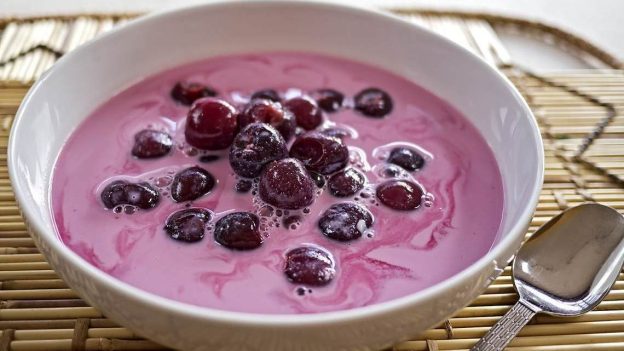
Cold Cherry Soup
Published on: July 16th/2025
Author: Lindsay Anderson & Davida S.F.
Recipe origin: Hungary
Known in Hungary as ‘hideg meggyleves,’ this cherry soup is a clever strategy for staying cool in hot weather and using up an abundance of fresh stone fruit. It can be made with either sour or sweet cherries. The version shared below comes from a cookbook written by Heritage Cookbook creator Davida and her Hungarian-born Grandmother, Ilona. In Davida’s own words:
“My grandmother and I decided to make this cookbook together. My grandmother has always been a great cook, I have many fond memories cooking and baking with her as well as eating around her table. It has been really special to learn more about my grandmother’s story and hear about the recipes she grew up eating in Hungary. Her mother, Gran, used to do most of the cooking and would sometimes allow my grandmother to help. These dishes included Potato Soup, Beef Goulash, and a fan favorite cucumber salad. My grandmother remembers her mother making Cold Cherry Soup in the summers, which was sweet and refreshing.”
5 cups water
½ cup sugar
½ cup red wine
¼ tsp. salt
Grated zest of ½ lemon (or ½ tsp. dried lemon flakes)
1 ½ lbs. sweet dark cherries
1 cup reduced fat sour cream
Pit the cherries and place the pitted cherries in a bowl and the pits in a large soup pot. Add water to the pits and bring to a boil. With a skimmer, remove the pits. Reduce heat and simmer for a few minutes.
Add the sugar, wine, salt, and lemon zest and bring back to a boil over medium-high heat. Boil for 5 minutes then add cherries. Bring to a simmer, turn the heat to low, cover and simmer for 5-15 minutes, then remove from the stove.
Can either add 1 tsp. sour cream to each serving or whip 1 cup sour cream into the soup and blend with a hand blender. Chill in the refrigerator 1-2 hours before serving.
Ready to turn your recipes into something memorable? Click here to get started!
June 10, 2025 | Posted in:

Miso Butter Onions
Submitted by: Kezia F.
Recipe origin: Southern California
This recipe comes from college senior Kezia, who created a cookbook for Esperenza Community Farms’ CSA boxes. The book informs CSA recipients about the produce they’ve received and gives ideas for how to cook it. If you find yourself with an excess of freshly-harvested onions, here’s how to turn them into stars of the meal, not just supporting characters!
8 onions
7 tablespoons unsalted butter, melted
1/3 cup miso paste
4 cups warm water
Preheat oven to 500°.
Halve the onions lengthwise. In a bowl, whisk together melted butter, miso paste, and warm water. Place the onions cut-side down in a high-sided baking dish and pour in the miso water. Cover and bake for 35 minutes. Turn the onions cut side up, baste well, and bake uncovered for another 45-50 minutes, basting every 10 minutes, until soft and browned.
Ready to turn your recipes into something memorable? Click here to get started!
May 29, 2025 | Posted in:
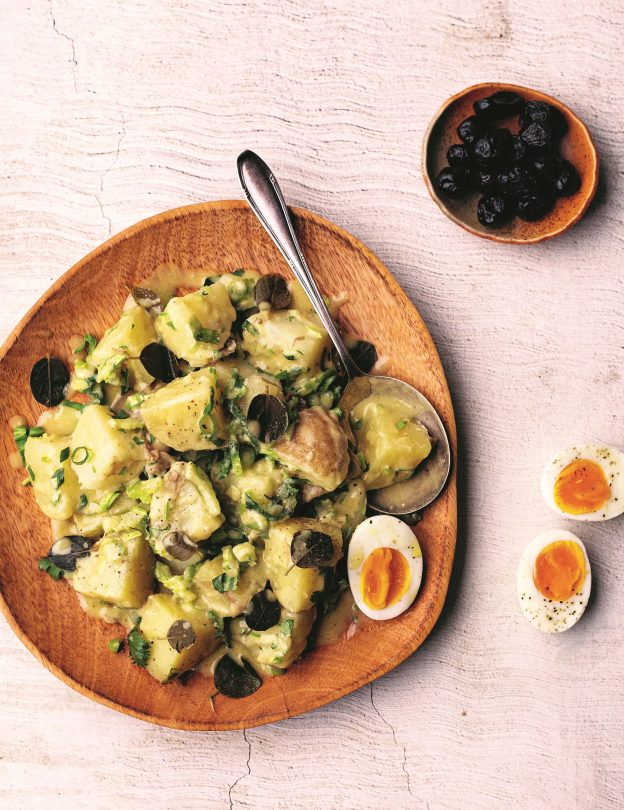
Thanks for Entering the Giveaway!
You’re now entered to win a copy of “My Cypriot Table” by Irene Matys!
Want to double your chances of winning? Follow us on Facebook and Instagram and you’ll be entered again. (If you already follow us, you’re entered twice automatically!)
The contest is open until Wednesday, June 5th, and the winner will be notified by email by Friday, June 7th. In the meantime, Irene has a gift for everyone who enters — her recipe for Warm Potato Salad with Tahini Vinaigrette:
Warm Potato Salad with Tahini Vinaigrette
“There’s nothing like a classic potato salad, but this version elevates it with a twist of Cypriot flavors. The slightly nutty tahini pairs beautifully with the tart lemon and gives it a delicious creamy flavor. This salad pairs wonderfully with any grilled meats, fish, or seafood but I also love it as a meal on its own. It’s just as delicious served cold and taken to a beach or park picnic.”
Salad:
1½ lb (670 g) yellow potatoes, skin on, scrubbed
½ tsp sea salt 4 large eggs
½ cup thinly sliced celery with leaves
⅓ cup finely chop fresh flat-leaf parsley
¼ cup thinly sliced red onions
⅓ cup sun-dried black olives or Kalamata olives, pitted
Lemony Tahini Vinaigrette:
⅓ cup + 1 Tbsp extra-virgin olive oil
3 Tbsp fresh lemon juice 2 Tbsp tahini
1 tsp Dijon mustard
1½ Tbsp pickled capers, drained from their brine
1 tsp sea salt
¼ tsp fresh ground pepper
To make the salad, place the potatoes in a large pot, cover with water, and add the salt. Bring to a boil, then reduce heat to a medium boil. Cook for 20 to 25 minutes or until fork-tender. Drain the potatoes, reserving 3 Tbsp of their water. Cut the potatoes into equal bite-size pieces. Place in a large bowl and toss with the reserved cooking water.
Fill another medium pot with enough water to cover the eggs and bring to a boil. Add the eggs and bring up to a rolling boil for 7 minutes. Drain and put them in an ice bath to cool. Once cool, peel and slice in half lengthwise.
While the potatoes and eggs are cooking, prepare the vinaigrette by whisking the olive oil, lemon juice, tahini, mustard, capers, salt, and pepper in a bowl.
Add the celery, parsley, and onions to the potato salad and toss with the vinaigrette. Serve immediately with the eggs and olives.

